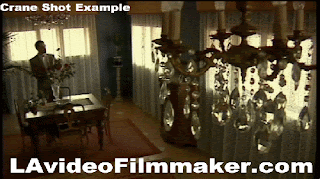TRACKING SHOT- A tracking shot is a shot in which the camera is mounted on a camera dolly; a mobile platform which steadily travels along a rail to create a smooth movement. In this shot the camera follows the character or an object (e.g. vehicle.) It can also be known as a dolly shot. Depending on the speed of the tracking, this shot can have different connotations:
- a sense of dreaming, hallucinations or trance if the tracking is extremely slow
- chaotic, tense and jumpy scenes if the tracking is extremely fast (e.g. car chase)
TILT SHOT- A tilt shot is when the camera tilts up or down, rotating on an axis. A downward tilt shot can be used to give a sense of inferiority or weakness such as an adult looking down at a small child. On the other hand, an upward tilt shot can give the opposite effect and signifies superiority and the sense of height and power. A popular scene is a tilt shot from the base of a tall building to the top, to represent the sheer size of it. They can also be used in conjunction with a point of view shot, where one character is looking another character or object up and down.
ZOOM - A zoom shot is as obvious as its name states, it simply uses the focal length on the camera to zoom in and out of a shot. They simulate tracking shots and are often used if the necessary equipment isn't available (e.g. dolly). However, zoom shots can be tricky to achieve unless you have an extremely good, most likely- expensive, camera which can effectively zoom in smoothly. If the zoom is jerky this will make the shot look unprofessional and unclear for the audience to follow. Zooming in isolates and focuses on a person or object whereas zooming out places that person or object in a wider context and the location can be seen clearly.
ARC SHOT- An arc shot is the movement of the camera in a full or semi-circle around an object or character. An arc shot is used to add drama to a film sequence and increases the intensity of the narrative. They are known to be greatly effective when filming a moving object, although a complicated shot, it holds the audience's attention.
CRANE SHOT- A crane shot is when a camera is suspended by a crane or a jib which moves electronically (usually). They are used when the camera needs to be a few feet higher than usual. An obvious use is when they want to view the actors or scenery from above or move up and away from them (which is a common way to end a scene or film). There are two types of crane shots:
- Rise up- camera rises vertically
- Fall down- camera moves vertically downward
PANNING SHOT- This is the movement of the camera from left to right in a fixed position which follows character movement, e.g. somebody walking or running. It is a very common shot used and can be successful if done on a smooth track to avoid any jerky movements. It can easily capture the audience's attention and leads them through the narrative or scenery thoroughly.





.gif)
No comments:
Post a Comment